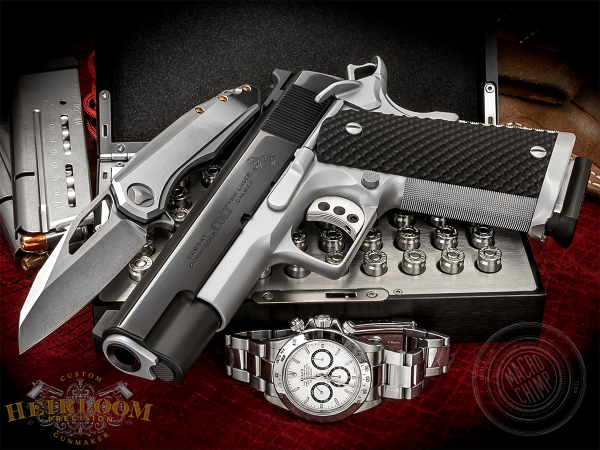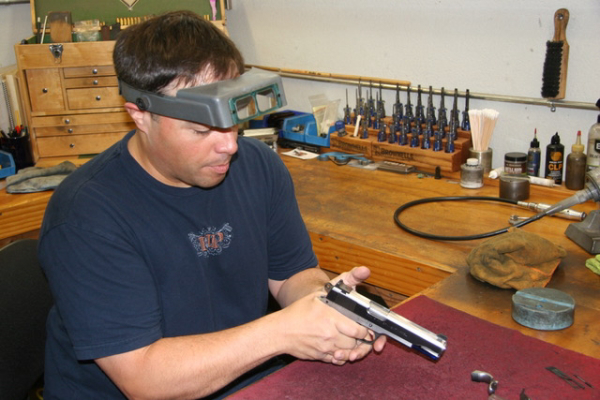Last week, in Moats’ Notes, he began an interview of world-class pistolsmith Jason Burton, of Heirloom Precision. The interview continues here.

9mm vs .45 ACP 1911’s
GM (Greg Moats): “With the substantial increase in popularity of 9mm 1911’s, what are some of the differences and added challenges when building a 9mm vs a .45?”
JB (Jason Burton): “9mm’s need to have a ramped barrel, not because of pressure, it doesn’t need to have a fully supported case, we can still throat it like we would a .45. But I want a ramped barrel in the gun because I want the feed ramp to be deeper, I need it to have the best chance of getting the top round out of that magazine. Also it needs to have ejectors that are tall enough and long enough that they start to move the fired case out of the ejection port before the round in the magazine has a chance to influence it or fowl it and push it off of the extractor.”
“When they built the original 9mm 1911’s they really should have moved the extractor position inboard or set it an angle because the breech face is narrower but the extractor channel is in exactly the same spot in relation to the firing pin. So the extractor has to be able to move in more, and since the rim on a 9mm is smaller (than a .45) the extractor hook has to be smaller as well.”
“There are two ideas on how to fit extractors to a 9mm. One camp says that it needs to be fit exactly like a .45. With a .45 the actual tip of the hook isn’t touching the case, it’s the inside of the hook that is touching. The hook simply pulls the round but it’s not putting side pressure on the case. That’s the correct method for a .45. The other camp says that you need the tip of the hook itself to contact so that you have more contact because the cases are so much smaller than a .45.”
“I try to have contact on both the inside of the hook and the tip. The key is that it can’t push the round off of being square on the breech face. If the round isn’t square on the breech face you can get an ejector strike that may not be the same or the magazine begins to influence it and pushes it off the extractor and you wind up getting a double-feed or stove pipe.”
“Those three things in a 9mm are the keys to making them work: a ramped barrel, an ejector that is the right height and length and an extractor that controls the round and allows the round to sit flat on the breech face….if you can do those 3 things and you’ve got good magazines, you can make a 9mm run all the time.”
Magazines
GM: “What are your recommendations regarding magazines?”
JB: “In the .45 ACP I’m a big fan of the 7 rd. Wilson #47 magazine. The reason is that it has the least amount of variables. I’m not opposed to 8 round magazines, however if somebody has an off the shelf gun that’s not a custom built pistol they are doing themselves a favor by getting a 7 round magazine. That doesn’t mean it won’t work with an 8 rounder, it just means that there are the least amount of variables with the 7 rounder.”
“If you look at how an 8 rd. vs. a 7 rd. magazine wants to feed in the gun, the difference in the gap between the top round and the second round is different and the cartridge will want to nose dive more with an 8 round magazine than with a 7 round magazine. If the gun is set up correctly it will work with almost any magazine that’s out there, but there has to be enough feed ramp depth so that when that top round in an 8 round magazine wants to nose dive, the feed ramp is deep enough that it pushes the round back up and allows the round to get under the extractor. Bottom line, the 8 round gives it too much room to nose dive. Overall the Wilson #47 is the gold standard magazine. If however a person wants an 8 round magazine, the Wilson 500C-HD, with the square wire in it is the best 8 round magazine that’s ever been built. It has a longer tube than the their #47D 8 rounder which allows for more spring and a better spring but it’s not any longer when it’s in the gun, it’s the same overall length as the #47.”

Springs
GM: “Shooters have debated spring weights for years. What weights do feel are best?”
JB: “I set up a gun with a 21 lb. mainspring. The original is 23 lbs. but it doesn’t need to be that heavy and the mainspring will absolutely influence how the trigger feels. For a recoil spring, the standard spec with the .45 was 16 lbs. I like 18 1/2 lb. springs in mine, not because the gun needs it but simply because they last longer. A gun that is set up correctly will work with a 12 lb. spring.”
“One of the things that the recoil spring needs, regardless of caliber is enough closing pressure based upon how tight the gun is. When you slowly ease a slide into battery you can feel a slight hesitation toward the end of the forward movement. This is where the barrel feet are meeting the slide stop pin and you need enough closing pressure to get the barrel to go over the slide stop. So depending upon how tight a gun is, a lesser weight recoil spring may not have enough closing pressure to get the slide closed all the way. As the round in the magazine is feeding into the chamber it buffers the movement of the slide and makes situation worse. In a .45, a 16 lb. recoil spring is more than enough, in fact with 230 gr. Hardball you can shoot the gun with a 12 or 14 lb. spring and you’re not going to beat the gun up.”
“In a 9mm, getting the right recoil spring becomes even more important because we’re already starting with a lighter spring. When we talk about match-fit guns that have a higher level of fit between the barrel feet and the slide stop, the closing pressure becomes even more important. It’s a balancing act between the closing pressure needed and how the gun is built and fit so each gun is potentially different.”
Overall Accuracy
GM: When I started, it was popular for gunsmiths to offer a general, “accuracy job” when customizing a 1911. What alterations are the most important to increase the inherent accuracy of the gun?”
JB: “Let’s forget about the trigger and sights for a moment. If you start with a stock gun, Colt or whatever, the first thing you can do to increase its mechanical accuracy is fit a better barrel bushing and isolate the movement of the barrel at the front.”
“After that you’re going to have to fit a barrel. The things that are a detriment to accuracy in production guns are barrels that have ‘end-shake’ which is the slide’s ability to move before it moves the barrel and the barrel’s ability to move within the slide. Also if a gun has barrel feet that aren’t correctly sized to the slide stop, the barrel is not being pushed up to a consistent position.”
“Correcting these things will increase the gun’s inherent ability to be accurate.”
I was fortunate and thankful that Jason devoted a significant amount of time to sit down and talk with me and time is a gun smith’s coin of the realm.
“Golden Age” is defined in part as “….the period when a specified art, skill or activity is at its peak.” Not taking anything away from the gunsmiths of the past, Jason and perhaps a handful of others are standing on their shoulders and insuring that this is the Golden Age. Hopefully future smiths will stand on Jason’s shoulders and keep the Golden Age from ever culminating.
Greg Moats was one of the original IPSC Section Coordinators appointed by Jeff Cooper shortly after its inception at the Columbia Conference. In the early 1980’s, he worked briefly for Bianchi Gunleather and wrote for American Handgunner and Guns. He served as a reserve police officer in a firearms training role and was a Marine Corps Infantry Officer in the mid-1970’s. He claims neither snake-eater nor Serpico status but is a self-proclaimed “training junkie.”